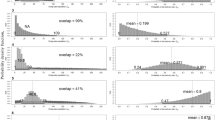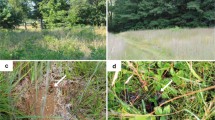Abstract
Monitoring the number of animals in a wildlife population is an important task. In this paper, we estimate the number of active and successful bald eagle nests in a specific region using dual frame sampling techniques. The dual frame method combines independent samples from an incomplete list frame and an area frame that is assumed to be complete. Hartley's screening estimator is used to combine sample information from both frames. This methodology will be useful for monitoring any wildlife population where the breeding individuals have highly visible nesting territories which tend to be stable over many years.
Similar content being viewed by others
References
Bartish, T. (1994) Design considerations for trust species monitoring: bald eagles and their habitat in the Great Lakes region. Biomonitoring of Environmental Status and Trends (BEST) Program.
Bosecker, R.R. and Ford, B.L. (1976) Multiple frame estimation with stratified overlap domain. In Proceedings of the Social Statistics Section, American Statistical Association. pp. 219-24.
Cochran, R.S. (1965) Theory and applications of multiple frame surveys. Ph.D. thesis, Iowa State University.
Cochran, W.G. (1977) Sampling Techniques. John Wiley & Sons, New York.
Fuller, W.A. and Burmeister, L.F. (1972) Estimators for samples selected from two overlapping frames. In Proceedings of the Social Statistics Section, American Statistical Association. pp. 245-9.
Haines, D.E. (1997) Estimating population parameters using multiple frame and capture-recapture methodology. Ph.D. thesis, North Carolina State University.
Hansen, M.H., Hurwitz, W.N., and Madow, W.G. (1953) Sample Survey Methods and Theory vol 1, John Wiley & Sons, New York. pp. 516-56.
Hartley, H.O. (1962) Multiple frame surveys. The Proceedings of the Social Statistics Section, American Statistical Association. pp. 203-6.
Hartley, H.O. (1974) Multiple frame methodology and selected applications. Sankhyá C, 36(3), 99-118.
International Joint Commission (1991) A proposed framework for developing indicators of ecosystem health for the Great Lakes region. Council of Great Lakes Research Managers, International Joint Commission, Windsor, Ontario, Canada. pp. 1-47.
Kott, P.S. and Vogel, F.A. (1995) Multiple-frame business surveys. In Business Survey Methods, B.G. Cox (ed), John Wiley & Sons. pp. 185-203.
Kubiak, T.J. and Best, D.A. (1991) Wildlife risks associated with passage of contaminated, anadromous fish at federal energy Regulatory Commission licensed dams in Michigan. Division of Environmental Contaminants, U.S. Fish and Wildlife Service, East Lansing, MI, USA.
Kubiak, T.J. and Weseloh, D.V. (1992) Herring gulls as a surrogate for bald eagle exposure. In Proceedings of the Third Expert Consultation Meeting on Bald Eagles in the Great Lakes Basin, International Joint Commission, Windsor, Ontario, Canada.
Lund, R.E. (1968) Estimators in multiple frame surveys. In Proceedings of the Social Statistics Section, American Statistical Association, pp. 282-8.
Nealon, J.P. (1984) Review of the multiple and area frame estimators. U.S. Department of Agriculture, Statistical Reporting Service, Washington, DC, USA, Staff Report 80.
Thompson, S.K. (1992) Sampling, John Wiley & Sons, New York.
Wiemeyer, S.N., Bunck, C.M. and Stafford, C.J. (1993) Environmental contaminants in bald eagle eggs-1980-84-and further interpretations of relationships to productivity and shell thickness. Archive Environmental Contaminant Toxicology, 24, 213-27.
Author information
Authors and Affiliations
Rights and permissions
About this article
Cite this article
Haines, D.E., Pollock, K.H. Estimating the number of active and successful bald eagle nests:an application of the dual frame method. Environmental and Ecological Statistics 5, 245–256 (1998). https://doi.org/10.1023/A:1009673403664
Issue Date:
DOI: https://doi.org/10.1023/A:1009673403664




